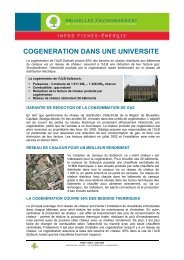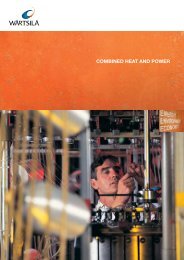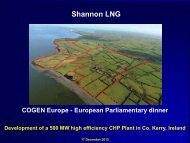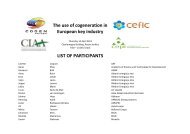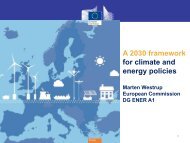DENMARK - COGEN Europe
DENMARK - COGEN Europe
DENMARK - COGEN Europe
Create successful ePaper yourself
Turn your PDF publications into a flip-book with our unique Google optimized e-Paper software.
Small-scale CHP<br />
Factsheet<br />
<strong>DENMARK</strong><br />
What is small-scale CHP<br />
There are many different definitions of small-scale CHP. Small-scale CHP units are run both as heating appliances,<br />
providing space heating and warm water in residential or commercial buildings like conventional boilers, and in industries<br />
that require heat for their processes. Unlike a boiler, small-scale CHP generates electricity together with the heat at very<br />
high efficiencies and therefore helps to save fuel, cut greenhouse gas emissions and reduce electricity costs. The<br />
<strong>Europe</strong>an Cogeneration Directive defines small-scale CHP as all units with an electrical capacity of less than 1 MW. This<br />
factsheet will focus on units in this size range. These can be used to provide heating and electricity to district heating<br />
schemes, apartment buildings, commercial buildings and small industries. These products are already available<br />
commercially.<br />
The <strong>COGEN</strong> Challenge project<br />
The goal of the <strong>COGEN</strong> Challenge project is to facilitate the development of a significant number of small-scale and micro<br />
cogeneration projects in <strong>Europe</strong>an cities and towns, as well as in residential areas and industries. <strong>COGEN</strong> Challenge has<br />
developed a broad range of support tools and structures to facilitate small-scale cogeneration projects. Through these,<br />
the project will build local capacity to successfully develop small-scale cogeneration projects. Regional facilitators will also<br />
offer guidance and help small-scale CHP investment projects materialise.<br />
Country information<br />
CHP accounts for the majority of installed Danish<br />
generation capacity. However, only a fraction of the<br />
total installed capacity qualifies as small scale<br />
cogeneration. Out of 857 units registered nationwide<br />
in 2003, only about 300 of these had an electrical<br />
capacity under 1 MWe, with an overwhelming<br />
majority of these units in the services sector.<br />
There are very few micro-CHP units (under 50 kWe)<br />
installed in Denmark, despite the presence of a local<br />
micro-CHP manufacturer. Based on best available<br />
information there was about 100 micro-CHP units<br />
installed in the country as of late 2005.<br />
Market Potential & Environmental Benefits<br />
The potential for residential micro-CHP in Denmark is<br />
comparatively low due to the existence of large citywide<br />
district heating networks. These are the legacy<br />
of several decades of intelligent urban planning and<br />
mandatory recourse to district heating in urban areas.<br />
Executive Orders 772 and 582 of 2000 have made it<br />
mandatory for municipalities to ensure that all plants<br />
above 1 MWe be converted to CHP production.<br />
Outside the urban centres natural gas availability is<br />
often an issue. Until 2004 the use of biomass as a<br />
fuel was actively promoted for decentralised CHP,<br />
with the adoption of a 10% fuel consumption target.<br />
Main contractual, technical and<br />
administrative requirements<br />
Renewable energy, electricity and heating are<br />
covered by the consolidated version of the Act on<br />
Electricity Supply N°286 of 20 April 2005 and the<br />
Heat supply act N°772 of 24 July 2000. In addition to<br />
the above regulations, Denmark has created a<br />
comprehensive legislative framework promoting<br />
energy savings in all sectors of the economy.<br />
Financial and regulatory support<br />
The scheme supporting the production of electricity<br />
at decentralised CHP plants, when production is<br />
based on renewable sources of energy or natural<br />
gas, is the single largest subsidy scheme. Supporting<br />
small-scale CHP units is a part of the shift from<br />
centralised to decentralised production. The subsidy<br />
depends on the fuel type. Existing plants with output<br />
over 5 MW are eligible for an individual subsidy<br />
corresponding to that received in the period 2001-<br />
2003. The subsidy is paid for 20 years from the date<br />
of the grid connection and for at least 15 years as<br />
from 1 January 2004.<br />
Plants of 5 MWe or under are eligible for a subsidy<br />
depending on when electricity production takes<br />
place. Combined with the market price, the subsidy<br />
ensures a tariff called three-tier tariff. At the end of<br />
2006 the tariffs were approx. 21 øre/kWh at low<br />
demand, approx. 46 øre/kWh at high demand and<br />
<strong>COGEN</strong> Challenge Denmark Factsheet<br />
Date of release: December 2007
approx. 61 øre/kWh at peak demand. The mean<br />
annual tariff is consequently approx. 35 øre/kWh.<br />
Renewable electricity (apart from wind power) from<br />
existing plants are eligible for a subsidy that together<br />
with the market price will ensure a tariff of 60<br />
øre/kWh for 20 years from the date of grid connection<br />
and for at least 15 years as from 1 January 2004.<br />
New renewable energy plants are eligible for a<br />
subsidy that together with the market price will<br />
ensure a tariff of 60 øre/kWh for 10 years and 40<br />
øre/kWh for the following 10 years. Special rules for<br />
new biogas plants mean that this subsidy is only<br />
applicable to plants connected to the grid before the<br />
end of 2008 and up to a ceiling of 8 PJ for total<br />
biogas use in Denmark.<br />
The Danish Government reduced the tax burden on<br />
decentralised CHP plants. This relaxation<br />
corresponds to reduced costs by an average of DKK<br />
1,000-1,500 per year for a normal house in a rural<br />
area. As far as centralised electricity production<br />
(most large-scale plants are multi-fuel CHP<br />
installations) is concerned, the biomass agreement of<br />
1993 forced central power stations to use biomass.<br />
This element of their production is eligible for a<br />
subsidy which when combined with market price<br />
ensures a tariff of 40 øre/kWh for a 10-year period.<br />
Contacts and useful Web links<br />
► DERA, the Danish national independent Authority<br />
for energy (http://www.energitilsynet.dk)<br />
► <strong>COGEN</strong> <strong>Europe</strong> (www.cogeneurope.eu)<br />
The <strong>Europe</strong>an Association for the Promotion of<br />
Cogeneration<br />
► Cogen Challenge Project (www.cogenchallenge.org<br />
)<br />
The sole responsibility for the content of this fact sheet lies<br />
with the authors. It does not represent the opinion of the<br />
Community. The <strong>Europe</strong>an Commission is not responsible<br />
for any use that may be made of the information contained<br />
therein.<br />
<strong>COGEN</strong> Challenge Denmark Factsheet<br />
Date of release: December 2007





